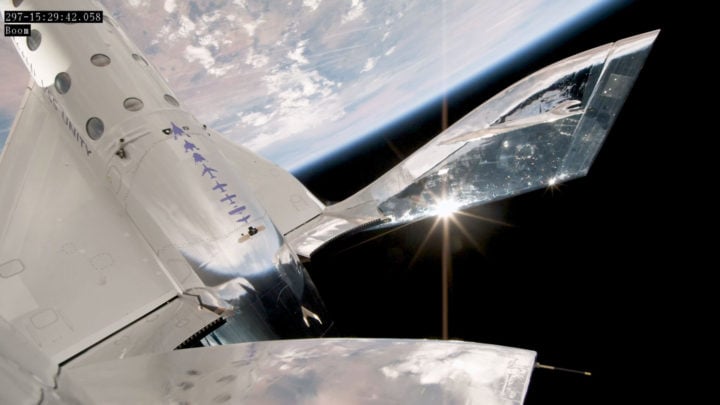Imagine a crew of astronauts headed to Mars. About 140 million miles away from Earth, they discover their spacecraft has a cracked O-ring. But instead of relying on a dwindling cache of spare parts, what if they could simply fabricate any part they needed on demand?

Spaceflight feather, as viewed aboard VSS Unity on June 8, 2024. The Virgin Galactic 07 flight carried Berkeley’s SpaceCal 3D printer and four other research payloads. Image credit: Virgin Galactic
A team of Berkeley researchers, led by Ph.D. student Taylor Waddell, may have taken a giant leap toward making this option a reality. On June 8, they sent their 3D printing technology to space for the first time as part of the Virgin Galactic 07 mission. Their next-generation microgravity printer — dubbed SpaceCAL — spent 140 seconds in suborbital space while aboard the VSS Unity space plane. In that short time span, it autonomously printed and post-processed a total of four test parts, including space shuttles and benchy figurines from a liquid plastic called PEGDA.
“SpaceCAL performed well under microgravity conditions in past tests aboard parabolic flights, but it still had something to prove,” said Waddell. “This latest mission, funded through NASA’s Flight Opportunities program and with support from Berkeley Engineering and the Berkeley Space Center, allowed us to validate the readiness of this 3D printing technology for space travel.”
He added, “We hope that someday it may be used to manufacture everything from parts and tools for spacecraft to new contact lenses and dental crowns for crew members.”
3D printing, also known as additive manufacturing, has evolved considerably since it was first patented in the 1980s. Hayden Taylor, associate professor of mechanical engineering, led a team of UC Berkeley and Lawrence Livermore National Laboratory (LLNL) researchers that invented Computed Axial Lithography (CAL) technology in 2017. This new type of additive manufacturing, which uses light to shape solid objects out of a viscous liquid, expanded the range of printable geometries and significantly increased the speed at which 3D parts could be printed. And it functioned well in microgravity conditions, opening the door to applications related to space exploration.
CAL technology is also what brought Waddell to Berkeley to pursue his Ph.D. in mechanical engineering. As an undergraduate at the University of Wisconsin, Madison, and a Pathways Engineer at NASA, Waddell became captivated by 3D printing — from its seemingly magical ability to transform an idea into a physical form, to its affordability and accessibility.
Upon learning about CAL, he reached out to Taylor and soon found himself at Berkeley. There, he spent countless hours in Taylor’s lab, working with other student researchers on new ways to leverage this technology for the greater good.
Reaching new heights
CAL stands apart from other 3D printing technologies because of its incredible speed — creating parts in as little as 20 seconds — and efficiency. By enabling astronauts to print parts quickly in an emergency and on demand, CAL potentially eliminates the need to bring thousands of spare parts on long-duration space missions.
“You can reduce that upmass, make these missions go faster and reduce risk by bringing manufacturing technologies with you,” said Waddell.
In addition, CAL’s unique ability to print well in microgravity conditions allows engineers to explore the limits of 3D printing from space.
“With CAL, we were able to demonstrate — first on those zero-G[ravity] missions and now on this spaceflight — that we can print parts in microgravity that are not possible on Earth,” said Waddell.
To date, CAL has shown that it can successfully print with more than 60 different materials on Earth, such as silicones, glass composites and biomaterials. According to Waddell, this versatility could come in handy for both the cabin and the crew.
“So, with the cabin, if your spacecraft is breaking down, you can print O-rings or mechanical mounts or even tools,” he said. “But CAL is also capable of repairing the crew. We can print dental replacements, skin grafts or lenses, or things personalized in emergency medicine for astronauts, which is very important in these missions, too.”
Someday, CAL may be used to print even more sophisticated parts, such as human organs. LLNL has received a grant from NASA to test this technology on the International Space Station.
“They’re going to basically do bioprinting on the Space Station,” said Waddell. “And the long, long-term goal is to print organs up in space with CAL, then bring them back down to Earth.”
Next, Waddell and his colleagues hope to begin work with NASA on developing and validating a single object that could support crew health and wellness, like a dental crown for an astronaut or a surgical wound closure tool.
“These experiments are really focused on pushing technology for the betterment of everyone,” said Waddell. “Even though it’s for space, there are always tons of ways it can benefit people back here on Earth.”
It’s also the type of technology that the Berkeley Space Center envisions being developed at its new 36-acre campus currently under development. The Berkeley Space Center will be a home for innovation and entrepreneurship, bringing together technologies developed by NASA and UC Berkeley, and commercialized through private industry. “Imagine a place where private companies can take inventions like those created by Taylor Waddell and make it possible for these important discoveries to break out of the lab and into the public realm,” said Darek DeFreece, a regent emeritus of the University of California and the head of UC Berkeley’s efforts to develop the Berkeley Space Center. “We were cheering as we watched the historic Virgin Galactic 07 flight.”
Source: UC Berkeley

